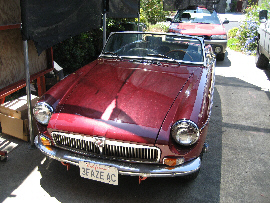Silicon Productions 

Upgrade of the MGB Electric Sports Car
Analysis by Warren Winovich
Page 1
Introduction. By installing a lithium-ion, iron phosphate, battery pack, the MGB electric car has performance that matches range and acceleration of the modern-designed EVs of major automobile manufacturers.
Recent reductions in the cost of lithium-ion batteries result in the price of the battery pack to be within the means of the EV hobbyist. According to studies reported by the Institute for Transportation Studies (Davis, UC, under direction of Andrew Burke), the delivered cost of these systems from China is "$300 – 400/kW-hr". This is comparable to the present cost for Optima, sealed cell, batteries of $290/kW-hr (with a 10% reduction for a quantity purchase of ten or more units). Moreover, for the same nominal energy storage, a lithium-ion pack is less than half the weight of the lead-acid Optima pack.
This study evaluates the performance of the MGB EV with a modest lithium-ion pack of about the same weight as that of the original pack. The original pack is rated: 96 Volts @ 100 A-hrs; energy storage: 9.6 kW-hrs; weight: 576 mounds. the proposed lithium-ion, iron phosphate, pack is rated: 112 V C~ 280 A-hrs; energy storage: 31.4 kW-hrs; weight: 511 pounds (twenty eight units). The driving weight of each vehicle is essentially the same; the lithium-ion version is actually 65 pounds lighter. Consequently, the power input to the motor is the same for both cases. The selection of a twenty-eight unit pack for the lithium-ion version results in identical average pack voltage during discharge; and the current draw from the pack is unchanged. The only major effect of the lithium-ion battery pack is the time to discharge as given by Peukert's Law. For the lithium-ion pack, discharge tine (to 2.5 V/cell) is:
t = (254 / I) 1/0.0968 , hours
where "I" is the current draw from the battery pack - the same as for the original lead-acid version.
The table below gives the range, economy of energy usage, and fraction of nominal capacity for the lithium-ion upgrade case.
| V,mph | Power Input, W | Current, A | Discharge time, hrs | Range, mi | economy W-hrs/mi | C(I)/C20 |
| 0 | 1628 | 16.3 | 17.091 | 0.0 | oo | 0.9950 |
| 5 | 1868 | 18.7 | 14.830 | 74.2 | 373.6 | 0.9905 |
| 10 | 2157 | 21.7 | 12.717 | 127.2 | 215.7 | 0.9856 |
| 15 | 2542 | 25.6 | 10.721 | 160.8 | 169.5 | 0.9802 |
| 20 | 3072 | 31.0 | 8.798 | 176.0 | 153.6 | 0.9741 |
| 25 | 3795 | 38.5 | 7.033 | 175.8 | 151.8 | 0.9671 |
| 30 | 4763 | 48.7 | 5,517 | 165.5 | 158.8 | 0.9596 |
| 35 | 6030 | 62.2 | 4.285 | 150.0 | 172.3 | 0.9519 |
| 40 | 7654 | 79.9 | 3.308 | 132.3 | 191.4 | 0.9440 |
| 45 | 9700 | 102.9 | 2.547 | 114.6 | 215.6 | 0.9362 |
| 50 | 12248 | 132.6 | 1.960 | 98.0 | 245.0 | 0.9284 |
| 55 | 15390 | 171.3 | 1.505 | 82.8 | 279.8 | 0.9205 |
Results of the calculated performance are shown on the 1st figure of range vs. velocity. Note that the results are for driving at steady speed over level roads. Results are shown for 100 percent depth of discharge and, for the practical case of 75 % depth of discharge. Maximum range occurs for 22 mph at 176 miles (100 % DOD). For 75 percent depth of discharge, maximum range is a respectable 132 miles. At 75 % DOD and a highway cruising speed of 50 mph, range is 74 miles with a reserve of 24 miles. These results represent remarkable performance for an EV.
Page 1
Start Previous Page Next Page
Page 1 2 3 4 5 6